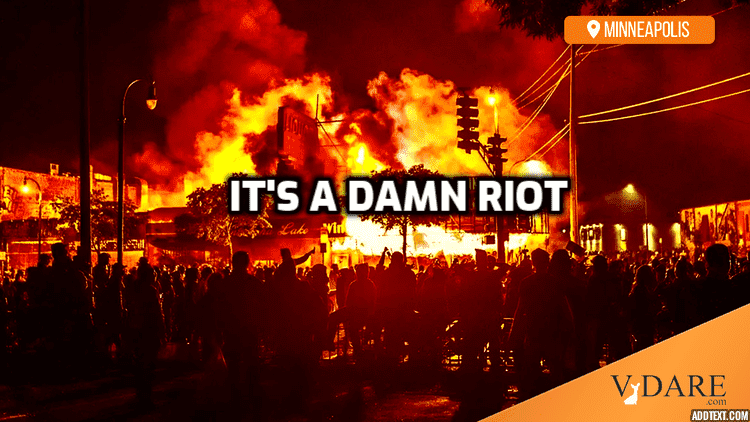
One-Year Anniversary of the Mostly Peaceful Protests Intensifying
By Steve Sailer
05/30/2021
Earlier (May 30, 2020): "Protest" or "Riot"? Establishment Appears Increasingly Demented as It Tries to Mold the Narrative
One year ago this weekend, the mostly peaceful protests spread from Minneapolis, with shoe stores around the country being looted. It’s worth looking back at a 2004 study of the impact of the 1960s black riots on black home values:
The Economic Aftermath of the 1960s Riots: Evidence from Property Values
William J. Collins & Robert A. MargoISSUE DATE May 2004
In the 1960s numerous cities in the United States experienced violent, race-related civil disturbances. Although social scientists have long studied the causes of the riots, the consequences have received much less attention. This paper examines census data from 1950 to 1980 to measure the riots’ impact on the value of central-city residential property, and especially on black-owned property. Both ordinary least squares and two-stage least squares estimates indicate that the riots depressed the median value of black-owned property between 1960 and 1970, with little or no rebound in the 1970s. Analysis of household-level data suggests that the racial gap in the value of property widened in riot-afflicted cities during the 1970s.
… Using both city-level and household-level data, we find negative, persistent, and economically significant correlations between riot severity and black-owned property values.
And from 2021 in The New York Times news section:
House Hunters Are Leaving the City, and Builders Can’t Keep Up
For years, people most wanted to live in places where it was the hardest to build. Now, with a rise in remote work, exurban areas look more appealing.
By Conor Dougherty and Ben Casselman
May 29, 2021… Just as notable as the level of new construction is where it is taking place. From the mountains of central Pennsylvania to the one-stoplight towns beyond Houston’s endless expanse to California’s San Joaquin Valley, developers are racing to build homes in areas that buyers used to judge beyond the outer limits of an acceptable commute.
Every housing boom redefines where the city ends. Fields beyond the old suburbs become the site of the new exurbs until the next development wave pushes farther still. Over the past decade, however, as high-paying jobs increasingly concentrated in a handful of big cities, workers from across the income spectrum spent a growing share of their paychecks to live in downtown neighborhoods and commuter-friendly areas.
There was plenty of affordable land on the urban fringes and in smaller cities, but home builders had trouble finding buyers there. The U.S. housing market was held back by a fundamental mismatch: The places where people wanted to live were the places where it was the hardest for developers to build.
Now, after a year of lockdowns and a push to continue working from home even as the pandemic wanes, the preference for closer-in living has weakened. This has helped unleash a wave of home building.
Over the past year, new home construction in small cities and suburban areas rose 15 percent, compared with less than 10 percent in big cities, according to data from the National Association of Home Builders. Would-be homeowners are flocking to the new farthest exurbs, where home builders can meet demand — and together they are again stretching the boundaries of a city and its surrounding sprawl.
Clearly, Zoom and fear of disease has much to do with the explosion in demand for housing in low density areas. But also … The Establishment deciding that calling the cops on criminals was racist tends to make a subdivision in the exurbs seem fashionable.
